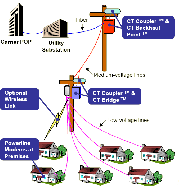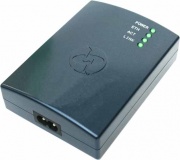Broadband Over Powerlines (BPL)
From Computing and Software Wiki
(New page: {|align="right" |- | BPL solution provides end-to-end broadband data and voice services using the existing power grid. |} '''Broadband over powerlines ...) |
|||
| Line 81: | Line 81: | ||
== See Also == | == See Also == | ||
| + | [[ Alternative Technologies for Ethernet]] | ||
| + | [[Network-Based Software Architectures]] | ||
| + | [[Wireless Network Security]] | ||
== References == | == References == | ||
Revision as of 04:00, 14 April 2008
Broadband over powerlines (BPL), also known as power-line internet or powerband, is the use of power line communication (PLC) technology to provide broadband internet access through ordinary electric power lines. A computer, or other device, needs only plug a BPL modem into any electric outlet in an equipped building to gain high-speed internet access. [1,9]
BPL works by coupling radio-frequency (RF) energy onto powerline wires, typically in the 1.6 to 80 MHz range, to transmit data without the need for a separate data line. The modulation scheme most often employed for BPL is orthogonal frequency division multiplexing (OFDM). [2,3,4]
BPL offers benefits over regular cable or DSL connections. The extensive infrastructure of the power companies, already in place, would allow people even in remote locations, where the fiber optics of the phone companies don’t reach, access to the internet with relatively little investment in equipment by the utility. Also, this ubiquitous availability makes it potentially easier for other electronic devices, such as televisions or sound systems, to connect to the internet or to network with one another. [2,5]
Contents |
Motivation for BPL Technology
Despite the proliferation of broadband technology in the last few years, there are still huge parts of the world that don't have access to high-speed Internet. When weighed against the relatively small number of customers Internet providers would gain, the cost of laying cable and building the necessary infrastructure to provide DSL or cable in rural areas is often too great. If broadband could be served through power lines, there would be no need to build new infrastructure. By slightly modifying the current power grids with specialized equipment, the BPL providers could partner with power companies and Internet service providers to bring broadband to everyone with access to electricity.
By providing high-speed data transmission between all of the electrical plugs in a house, there is also the potential to network all kinds of common appliances in a household. If your alarm clock, light switch and coffee maker could talk each other via a high-speed connection, mornings might be a lot different. [10]
Categories of BPL Service
There are two main categories of BPL service; in-house BPL and access BPL. [8]
In-House BPL
In-house BPL is broadband access within a building or structure using the electric lines of the structure to provide the network infrastructure. In other words, in-house BPL is networking machines within the same building together by simply having each machine plug into an electric outlet. HomePlug is an alliance of several vendors of in-house BPL products which has authored a standard for device compliance. [8,10]
Access BPL
Access BPL is the use of the electrical transmission lines to deliver broadband to the home. Access BPL is considered a viable alternative to Cable or DSL to provide the 'final mile' of broadband to end users. A BPL coupler placed at the pole converts the transmission medium from fiber optic (originating at the substation) to medium voltage power lines. Broadband signals traverse the medium voltage power lines, bypassing transformers, with repeaters placed every mile along the transmission path. At the final pole, a BPL wireless device can deliver the broadband to home-installed BPL wireless receivers, or, the signal can be sent to the individual homes via the low-voltage electrical lines and made available through any BPL wired receiver. [2,8,10]
BPL Modems
BPL modems use silicon chipsets specially designed to handle the work load of pulling data out of an electric current. Using specially developed modulation techniques and adaptive algorithms, BPL modems are capable of handling powerline noise on a wide spectrum.
A BPL modem is plug and play and is roughly the size of a common power adapter. It plugs into a common wall socket, and an Ethernet cable running to your computer finishes the connection. Wireless versions are also available.
BPL modems transmit in medium and high frequency (1.6 to 80 MHz electric carrier). The asymmetric speed in the modem is generally from 256 kbit/s to 2.7 Mbit/s. In the repeater situated in the meter room the speed is up to 45 Mbit/s and can be connected to 256 PLC modems. In the medium voltage stations, the speed from the head ends to the Internet is up to 135 Mbit/s. To connect to the Internet, utilities can use optical fiber backbone or wireless link. [9,10]
Managing Power Problems
The power flowing down high-voltage lines is between 155,000 to 765,000 volts. That amount of power is unsuitable for data transmission. It's too "noisy."
Both electricity and the RF used to transmit data vibrate at certain frequencies. In order for data to transmit cleanly from point to point, it must have a dedicated band of the radio spectrum at which to vibrate without interference from other sources. Hundreds of thousands of volts of electricity don't vibrate at a consistent frequency. That amount of power jumps all over the spectrum, creating interference. If it spikes at a frequency that is the same as the RF used to transmit data, then it will cancel out that signal and the data transmission will be dropped or damaged en route.
BPL bypasses this problem by avoiding high-voltage power lines all together. The system drops the data off of traditional fiber-optic lines downstream, onto the much more manageable 7,200 volts of medium-voltage power lines. Once dropped on the medium-voltage lines, the data can only travel so far before it degrades. To counter this, special devices are installed on the lines to act as repeaters. The repeaters take in the data and repeat it in a new transmission, amplifying it for the next leg of the journey.
In Current Communications Group's model of BPL, two other devices ride power poles to distribute Internet traffic. The CT Coupler allows the data on the line to bypass transformers. The transformer's job is to reduce the 7,200 volts down to the 240-volt standard that makes up normal household electrical service. There is no way for low-power data signals to pass through a transformer, so you need a coupler to provide a data path around the transformer. With the coupler, data can move easily from the 7,200-volt line to the 240-volt line and into the house without any degradation.
BPL Deployment
Deployment of BPL technology to provide high speed internet solutions has had noticeable impact on the world. A few key examples follow:
Smart Mosque Project
In March, 2008, BPL provider Velchip formalized three major partnerships to advance the world’s biggest BPL project. The first agreement was with investment firm Sarz Al Yahya Corporation, providing project financing of US$14 billion. Second, the company signed with US-based satellite infrastructure provider STM Networks Inc. who will use five satellites to provide communications services. Third, a 100-year agreement was exchanged with Nadhlatul Ulama Indonesia and Manhad Islam Hadhari, the Indonesian clients responsible for the network of mosques that will be converted during the BPL "Smart Mosque" project. [6,7]
According to the company’s chief executive officer Suhaimi Abdul Rahman, the US$14 billion “Smart Mosque” project will be rolled out over three years in Indonesia and will link together 400,000 mosques and serve 60 million users. The high speed internet connection of 224Mbps (megabits per second) will cost only RM5 (US$1.58) per user per month, making it the fastest and cheapest internet access in the world. [7]
Amateur Radio
Standards
Several competing standards are evolving for BPL technology including those of the IEEE and HomePlug Powerline Alliance. Currently, there is no globally accepted standard. [9]
IEEE
- IEEE 643-2004 "Guide for Power-Line Carrier Applications" is a standard for communication over the transmission line network (above 69kV).
- IEEE P1675 "Standard for Broadband over Power Line Hardware" is a working group working on hardware installation and safety issues.
- IEEE P1775 "Powerline Communication Equipment - Electromagnetic Compatibility (EMC) Requirements - Testing and Measurement Methods" is a working group focused on PLC equipment, electromagnetic compatibility requirements, and testing and measurement methods.
- IEEE P1901 "IEEE P1901 Draft Standard for Broadband over Power Line Networks: Medium Access Control and Physical Layer Specifications" is a working group for delivering broadband over power lines. The aim is to define medium access control and physical layer specifications for all classes of BPL devices - from long distance connections to those within subscriber premises.
- IEEE BPL Study Group — "Standardization of Broadband Over Power Line Technologies" drove the creation of the BPL related P1901 working groups. It still meets time-to-time looking to create new working groups if needed. [9,11]
Homeplug Powerline Alliance
The Homeplug Powerline Alliance is a trade group consisting of over 65 member companies. It was founded in March 2000 by leading technology companies to provide a forum for the creation of specifications for home power line networking products and services. The Alliance's mission is to enable and promote rapid availability, adoption and implementation of cost-effective, interoperable and standards-based home power line networks and products. The Sponsors and members of the Board of Directors of the Alliance include: Comcast, Earthlink, GE, Intel, Linksys, Motorola, Radio Shack, Samsung, Sharp, and Sony. The HomePlug Powerline Alliance has defined a number of standards: [9,12]
- HomePlug 1.0 — specification for connecting devices via power lines in the home
- HomePlug AV — designed for transmitting HDTV and VoIP around the home
- HomePlug BPL — a working group to develop a specification for to-the-home connection
- Homeplug CC — Command and Control is a low-speed, very low-cost technology intended to complement the alliance's higher-speed powerline communications technologies. The specification will enable advanced, whole-house control of lighting, appliances, climate control, security and other devices. HomePlugCC devices are available from Yitran Communications LTD and Renesas Techology. [12]
See Also
Alternative Technologies for Ethernet Network-Based Software Architectures Wireless Network Security
References
- [1] Held, Gilbert. "Understanding Broadband over Power Line". CRC Press, 2006.
- [2] Mollenkopf, Jim (2004). Presentation to Cincinnati IEEE Meeting. Retrieved on April 13, 2008.
- [3] Wikipedia (2008). Orthogonal frequency-division multiplexing. Retrieved on April 9, 2008.
- [4] Wikipedia (2008). Radio Frequency. Retrieved on April 9, 2008.
- [5] Trull, Bruce. "An Overview of Broadband over Power Line (BPL)". Rivier College, 2006.
- [6] Velchip (2008). Velchip. Retrieved on April 9, 2008.
- [7] Computerworld Malaysia (2008). Velchip Signs Three Major Partnership Deals to Advance the World’s Biggest Broadband Powerline Project. Retrieved on April 7, 2008.
- [8] Warkentin-Glenn, Denise. "Electric Power Industry in Nontechnical Language". PennWell Books, 2006.
- [9] Wikipedia (2008). Power Line Communication. Retrieved on April 6, 2008.
- [10] Howstuffworks (2008). How Broadband Over Powerlines Works. Retrieved on April 7, 2008.
- [11] IEEE (2005). IEEE Begins Standard to Define Communication Channel for Broadband-Over-Powerline Systems. Retrieved on April 9, 2008.
- [12] Homeplug (2008) Homeplug Power Alliance. Retrieved on April 9, 2008.
External Links
- Power Line Communication
- How Broadband over Powerlines Works
- BPL Presentation to IEEE
- BPL Interference Wiki
- BPL Interference Resolution Website
--Harrisds 23:58, 13 April 2008 (EDT)


